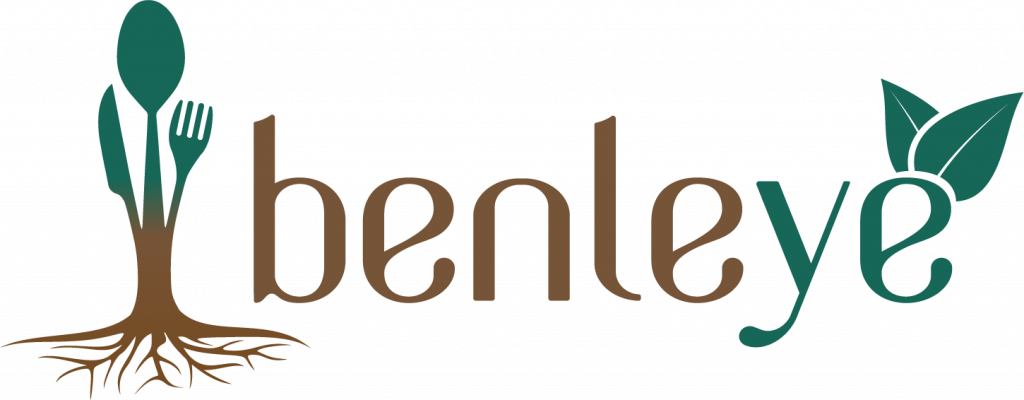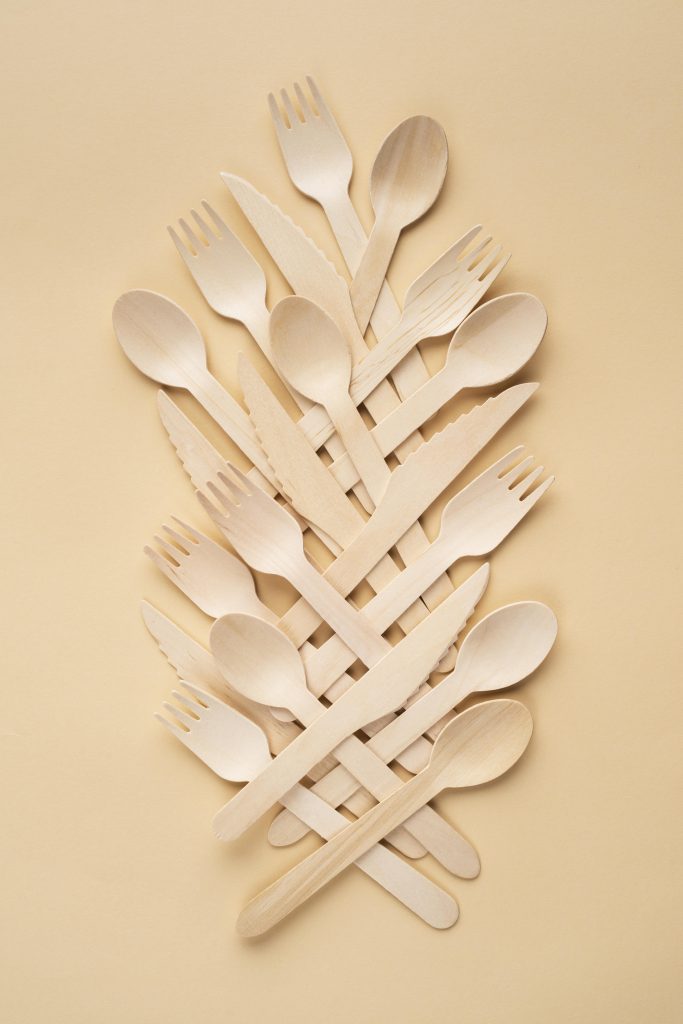Which Disposable Product Should I Choose?
In our previous articles, we talked about what is a disposable product and its types. In this article, we will ask this question which disposable product should we choose.
Today, the use of disposable products is increasing year by year. We all buy or have to use disposable utensils and plates from time to time. So which disposable product will we use? There are actually two main factors that we need to consider in our choices: production and its impact on the environment. Also, the other question we should ask is; where does it come from where does it go
Disposable cutlery is made in different types of materials. Choosing the cutlery best suited for your business will depend on the food you serve, environmental goals and your budget.
When choosing disposable products, we should pay attention to the following issues.
- Being compostable
- Be recyclable
- Being biodegradable
- Robust and Durable
- No burrs on
- Non-toxic
- Organic and all natural
- Environmentally friendly
- Heat Resistant
- Chemical content
- Damage to nature after production and consumption
- Danger to living health
- Carbon Emission
- Energy spent on life cycles
- Of course price
Some of the disposable material types and recycling methods are given below.
| Material Type | Intensity | Disposal method | temperature tolerance | Cheapest to Most Expensive |
| Polypropylene
(Plastic Number 5) |
Light Medium Weight Heavy Weight |
Disposable
Recycleable |
up to 250°F * |
£ ↓ £££££ |
| Polystyrene
(Plastic size 6) |
Light Medium Weight Heavy Weight |
Disposable
Recycleable |
up to 180°F * | |
| Plant Starch Material (PSM) | Varies by manufacturer | Disposable | up to 200°F * | |
| CPLA | Light Medium Weight Heavy Weight |
Disposable
Compostable |
up to 185°F * | |
| Molded Fiber | Varies by manufacturer | Disposable
Compostable |
up to 250°F * | |
| Bamboo | Varies by manufacturer | Disposable
Compostable |
up to 158°F * | |
| Wood | Varies by manufacturer | Disposable
Compostable |
up to 200°F * | |
| * Actual tolerance may vary by manufacturer and material. | ||||
We know that stainless steel or pure silver is always best when it comes to Spoons-Fork-Knifes set at events, weddings, picnics and when we are going to present to our guests. Unfortunately, silverware is not the most affordable or suitable cutlery for every occasion, and we often need to find alternatives for them.
When it comes to choosing disposable cutlery, many people generally prefer cutlery made of plastic. This is because plastic is inexpensive and readily available. Well for a sustainable life! What should we choose?
Where do they come from, where do they go?
Traditional Plastic
Where it comes from: Conventional plastics can be made from a variety of natural resources, including cellulose, coal, natural gas, and mostly petroleum. But just because they’re derived from natural sources doesn’t mean they’re healthy for you or the environment. Basically, the chemical units of plastic bond together to form extremely strong carbon bonds called polymers. This process does not occur in nature, so there are no known natural processes to break down polymers. However, plastic begins to wear off after washing – so traditional plastic flatware is not safe to use more than once.
Where it goes: Despite all efforts, traditional plastic containers are not usually thrown into the recycling bin after use. Typically, the higher the number inside the recycling symbol on the Plastic material, the harder the material is to recycle. Most plastic materials are technically recyclable, but are often not accepted by most recycling centers because they are not cost-effective.

Biodegradable Plastics
Where it comes from: Biodegradable plastics (aka bioplastics) are plant-based products made with polylactic acid, or PLA. They are typically made from fermented corn, but can also be produced using wheat, barley and potatoes. However, most of the corn they make is from genetically modified seeds. In fact, the largest PLA producer is a subsidiary of one of the world’s largest providers of GMO seeds.
Where it’s going: Biodegradable plastics are considered “carbon neutral” in that they come from renewable, carbon-absorbing plants and don’t emit toxic fumes when burned. However, PLA takes a long time to actually break down unless they are composted in a controlled environment. Even in suitable facilities, this process is said to take 60-180 days. Most parts of our world unfortunately do not have an industrial composting facility heated to 140℉ with regular digestive microbes. Even in the US, there are only 113 industrial-grade compost plants. Without these conditions, PLAs can take 100 to 1,000 years to decompose in a landfill.
Disposable Wood
Where it comes from: Wooden cutlery comes from trees, of course. The problem is that wooden containers require cutting down trees for production. Many wooden containers are made from fast-growing species such as bamboo, birch and beech, or from wood left over from the lumber industry, reducing environmental impact. In addition, this effect is further reduced when sustainable forest certified (FSC) wood products are purchased. Because we know that the same trees are planted in place of these certified products and replace them in a short time, so that the future of our forests is protected.
Where it goes: Wooden utensils can compost even in your own backyard pile in as little as 90 days. If wooden cutlery is in an area like the ocean, it won’t take nearly as long to compost or emit methane like its plastic counterparts.
Advantages and Disadvantages of Disposable Products
Polypropylene advantages and disadvantages
Advantages:
Polypropylene,
- It is the cheapest disposable cutlery option.
- It is the most flexible plastic and can withstand the most bending and bending before breaking.
- It has a heat tolerance of 121 0C/250 ℉ * before it deteriorates.
- Available in a variety of lengths and sizes, as well as light, medium and heavy.
Disadvantages:
polypropylene,
- It can be recycled in recycling facilities. However, this requires special recycling facilities and special recycling collection boxes. Unfortunately, they are difficult to recycle as they are not available in all regions.
- It is not compostable (compostable).
Polystyrene advantages and disadvantages
Advantages:
polystyrene,
- It is the second cheapest.
- It has a heat tolerance of 82 0C/180 ℉ * before it deteriorates.
- Available in a variety of lengths and sizes, as well as light, medium and heavy.
Disadvantages:
polystyrene,
- It is the hardest plastic cutlery option and breaks more easily under extreme pressure than polypropylene.
- It can be recycled in plastic recycling plants. However, this requires special recycling facilities and special recycling collection boxes. Unfortunately, they are difficult to recycle as they are not available in all regions.
- It is not compostable (compostable).
Advantages and disadvantages of Plant Starch Based Plastic Material (PSM)
PSM cutlery is also known as plant starch material cutlery. PSM cutlery is made from a combination of plastic such as polypropylene and plant starch materials such as corn and potato starch.
Advantages:
- PSM is more expensive than polypropylene or polystyrene plastic cutlery, but can provide cost savings compared to other eco-friendly disposable cutlery options
- PSM cutlery is made from 20-30% plastic and 70-80% plant materials. The plastic component gives it the density and strength that needs to be bent before it breaks.
- PSM has a heat tolerance of 93 0C/200 ℉ * before it breaks down.
Disadvantages:
- PSM has lost popularity in recent years due to advances in other cutlery options.
- Unlike polypropylene or polystyrene, PSM cutlery is not manufactured as light, medium or heavy weight as an indication of cutlery density or size.
- PSM cutlery cannot be completely composted (composted) because it is made of plastic materials, 20-30% of which will not decompose.
- PSM cutlery is not recyclable.
Advantages and disadvantages of Crystallized Polylactic Acid (CPLA)
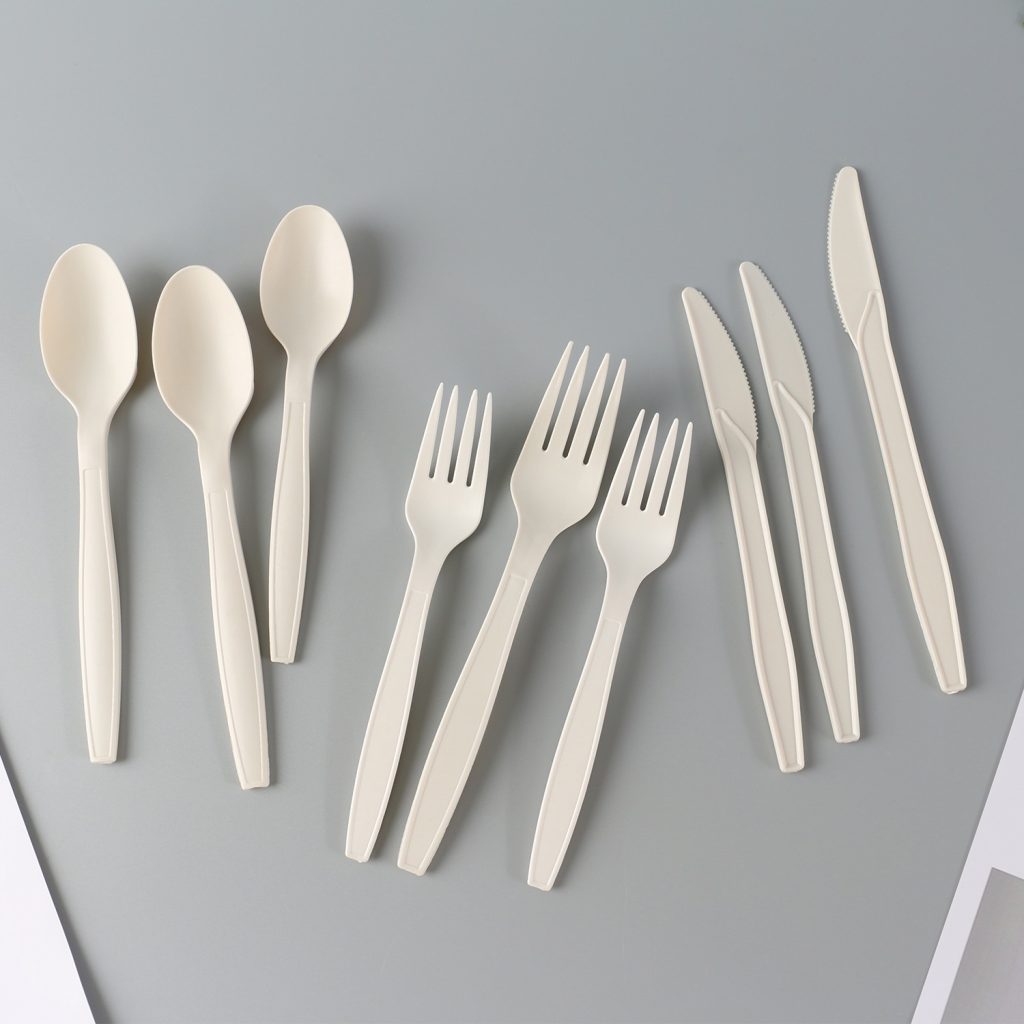
CPLA, also known as crystalline polylactic acid, is sometimes referred to as PLA. Corn, starch, sugar etc. Polylactic acid (PLA), a plastic substitute derived from the fermentation of 100% renewable and biodegradable plant resources, is fast becoming a popular alternative to traditional petroleum-based plastics.
Bioplastics can be made from a number of different plant-based products such as starches, corn oil and even fruit skins and seeds. Because they contain no chemical fillers, they are unlikely to leach harmful chemicals into our food or into our environment. They also produce a much smaller carbon footprint than traditional plastics in their manufacture and composting. Less energy and fossil fuels are needed to produce them; less pollutants are released during its lifetime; and minimize overall waste and plastic pollution, making them really good alternatives.
Advantages:
CPLA,
- It is more expensive than disposable plastic cutlery, but is the cheapest eco-friendly option.
- PLA is technically “carbon neutral” as it comes from renewable, carbon-absorbing facilities as another way to reduce our greenhouse gas emissions in a rapidly warming world.
- PLA will also not emit toxic fumes when burned
- PLA cutlery is certified compostable and can be composted within 60 – 180 days in commercial composting facilities.
- PLA has a heat tolerance of 85 0C/185 ℉ * before it deteriorates.
- PLA can be produced on demand in light, medium and heavy weight, various lengths and sizes.
Disadvantages:
- It is clear that PLA is not a panacea for tackling the world’s plastic waste problem. Because it can only be composted in special facilities.
- CPLA is very hard and will break under extreme pressure.
- Even with regular feeding of digestive microbes in an industrial fertilizer plant heated at high temperatures, PLA components can be fertilized in 60-180 days. Other than that, PLA will still be just like its non-biodegradable counterparts if they are thrown away. According to analysts, it is estimated that it can take between 100 and 1,000 years for a PLA bottle to decompose in a landfill.
- Another problem with PLA is that since it has a different origin than regular plastic, it must be kept separate while being recycled so that it doesn’t pollute the recycling stream. In other words, PLA-based disposable products must be recycled separately from normal plastics. However, since it is not distinguished from other plastics in appearance, many people cannot understand this difference and throw it in the recycling bins where other plastics are thrown. However, in order to truly decompose, they must be composted separately from other plastics in industrial composting facilities. Therefore, if you are going to use cutlery made of bioplastic, you need to be careful to dispose of them properly. Unfortunately, the number of these facilities is very few around the world, so PLA is unlikely to be a good compostable alternative.
- Another disadvantage of PLA is that it is made from genetically modified corn. With the demand for corn growing not only to produce PLA but even to make ethanol fuel, it is not surprising that companies producing Genetically Modified (GMO) corn are tampering with their genes to achieve higher yields. However, the future costs of genetic modification to the environment and human health are still largely unknown and may be very high.
Disposable Bamboo advantages and disadvantages
Bamboo is a rapidly renewable resource, making it a great option for disposable cutlery.
Bamboo is more expensive than plastic and CPLA cutlery.
Advantages:
- Bamboo cutlery is compostable
- It is smooth and light.
- Bamboo has a heat tolerance of 93 0C/200 ℉ *.
Disadvantages:
- Bamboo cutlery, the density, size and weight of the cutlery vary by manufacturer.
- Bamboo cutlery does not have a standard color. Color may vary for each piece.
Disposable Molded Fiber advantages and disadvantages
Molded fiber is made from a blend of recycled cardboard, newsprint, sugarcane, wheat fiber and other natural plant materials.
Molded fiber is the same as bamboo price.
Advantages:
- Molded fiber cutlery is compostable and will compost in 60-180 days in commercial composting facilities.
- Molded fiber has a heat tolerance of 121 0C/250 ℉ *.
- For facilities that need a safe (not sharp) cutlery option, such as prisons or hospitals, molded fiber is the best option.
Disadvantages:
- Molded fiber is the least durable cutlery option.
- Molded fiber cutlery will become soft if left in liquid for too long.
- Molded fiber cutlery varies in size and weight by manufacturer due to cutlery density or durability.
Disposable Wood Pros and Cons
Wooden cutlery can be made from various wood species such as birch, beech, pine, willow or poplar.
Wood is the most expensive option.
Advantages:
- Wooden cutlery can be composted and used as fertilizer in any fertilizer environment.
- Wooden cutlery can be produced without the use of any chemicals. As BENLEYE Company, we produce completely organic and smooth without coating, bleach or dye.
- Wooden cutlery has a heat tolerance of 93 0C/200 ℉ *.
- You can enjoy food by using wooden utensils in all kinds of food, from soup to salad. Won’t warp, splinter or melt when used with hot food. Also, they never change the taste of the food, so you can use it while serving any type of food.
Disadvantages:
- Expensive compared to other alternatives
Wooden cutlery is porous and absorbent, allowing it to absorb bacteria and moisture from food and liquids. - If wooden cutlery is not produced properly or has a defect, it can cause the wood to crack and splinter, which has the potential to harm your guests.
- Bending wooden cutlery can cause cracking and splintering.
- Some types of wood, such as cedar or cypress, can also contaminate food with oily resins and strong odors.
- If it is not produced from FSC certified products, the future of forests may be endangered. FSC certified disposable wood products should be used for sustainable forests. BENLEYE Organic Wooden Spoons, Forks, Knives are
- FSC Certified and care about the future of forests.
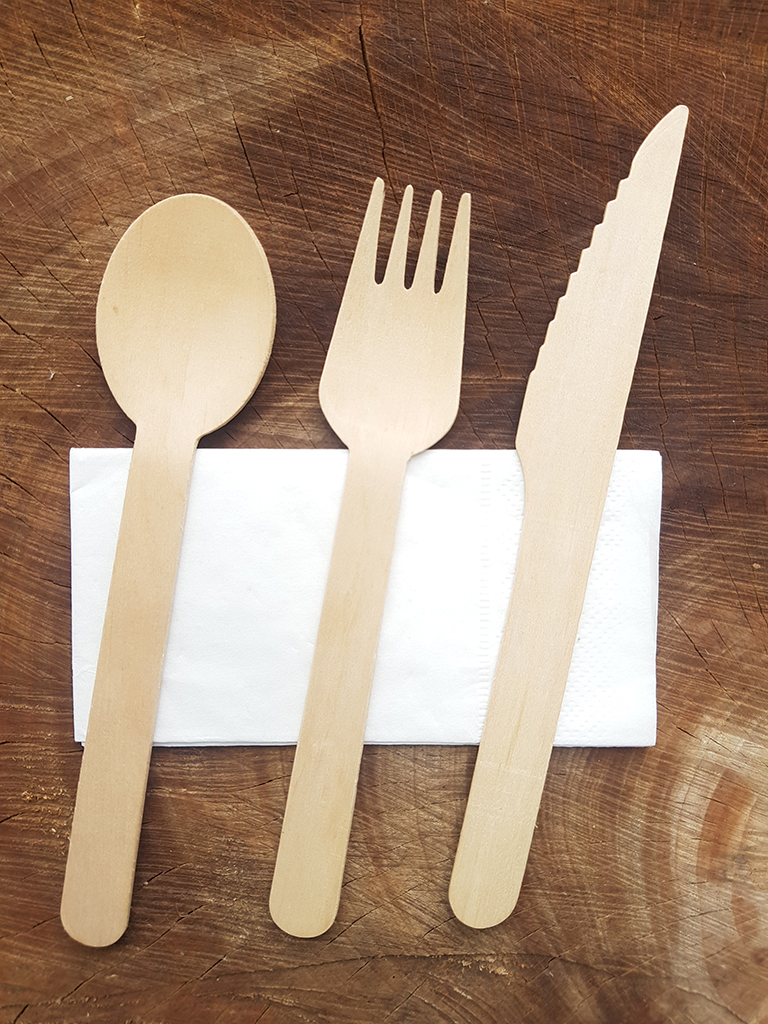
So Which Disposable Product Should We Use?
Let’s put the options on the table and see which one stands out more. On the one hand, we have compostable plastics, which are usually made from polylactic acid derived from corn (it is also possible to make from other plants such as wheat, barley and potatoes) or PLA. On the other hand, wood from birch, beech, bamboo and other woods.
First off, both are better than traditional plastic cutlery. Pure plastic containers are made from petroleum, often cannot be composted, and can take up to 100 years to begin to decompose. Therefore, if you must use disposable utensils, we should definitely avoid regular plastic.
The section of the TRT Documentary about the damage caused by Disposable Plastics and other plastics to nature:
While it takes more resources to produce wood products, wood has less of an impact when you look at a product’s entire life cycle. In addition, considering that petroleum resources are limited and it takes time to regenerate, it is more advantageous to use FSC Certified wood products.
PLA products are usually made from corn and are most likely made from GMO products. When it comes to PLA in Hot Coffee and other hot products, depending on what you think of GMO crops is another factor to consider. In these cases, it will be healthy and delicious to use Chemical-free Disposable Wooden Mixers.
But the real advantage of wood comes after you’re done. As we’ve explained, PLA containers are in theory compostable; That is, under the right conditions, it will decompose and leave no toxic residue behind. But here the “right conditions” is the key phrase. For PLA to biodegrade, it will not be degraded efficiently in a backyard compost pile, as it needs the heat and microbes found in commercial composting facilities by being collected in the right recycling bins. However, there is no need for a separate recycling collection box or facility to compost wooden products. It disappears in nature in a very short time without leaving any harmful residues in any place by itself compared to plastic.
Only when we buy PLA plastics with the Biodegradable Products Institute logo do we know that the product has passed third-party testing for fertilizer. Even if compostable plastics are purchased, there is no guarantee that they will have a chance to perish. The problem is that PLA looks like regular old plastic and that’s why many unconscious consumers throw them away. The confusion is that well-meaning people often mistake PLA products for plastic, so they send them to plastic recycling facilities, not private composting facilities. Therefore, these compostable plastics are likely to end up in a landfill where they will release climate-warming methane instead of fulfilling their true destiny.
However, wooden spoon cutlery doesn’t need a bin for composting, so diners are more inclined to dispose of it properly. Better still, you don’t even need a large plant to break up the wood, simply because these products can compost beautifully in a short time (90 days) even in a backyard. When disposable wooden products are thrown into the sea and ocean, if they find their way out in the water, they will probably decompose faster than a PLA and will not harm living things.
Here you go: PLA and wood. You may need to set aside a little more cash for the wooden options, but for the future we’d say it’s worth it.
So if you had to choose between disposable PLA or wood, which would you choose? As BENLEYE ORGANIK, we produce chemical-free, FSC certified, 100% compostable, Disposable Wooden Spoon, Cutlery, for those who care about future generations, nature and living things and their own health.
For a livable future, choose to live instead of Plastic.
Benleye Disposable Wooden Fork-Spoon-Knife
Benleye Disposable Wooden Spoon, Wooden Fork and Wooden Knife Features are given below.
| Spoon | Fork | Knife | |
| Size | 160 mm | 160 mm | 175 mm |
| Thickness | 1,6 mm | 1,6mm | 1,6mm |
| Width | 30 mm | 28 mm | 20 mm |
| Material | Birch | Birch | Birch |
| Compostable | Yes | Yes | Yes |
| Harmful Chemical | No | No | No |
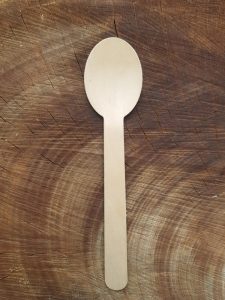
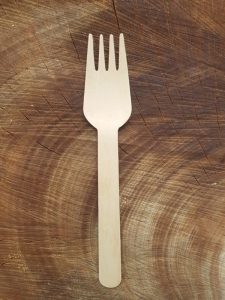
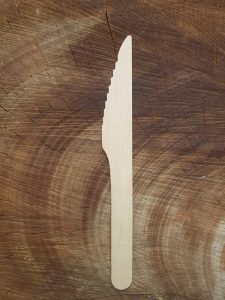
Benleye Organic products are shipped all over the world. Communication:
e-mail: trade@benleye.com
e-mail: info@benleye.com
Tel: +90 533 265 72 61

 Türkçe
Türkçe Deutsch
Deutsch Ελληνικά
Ελληνικά
